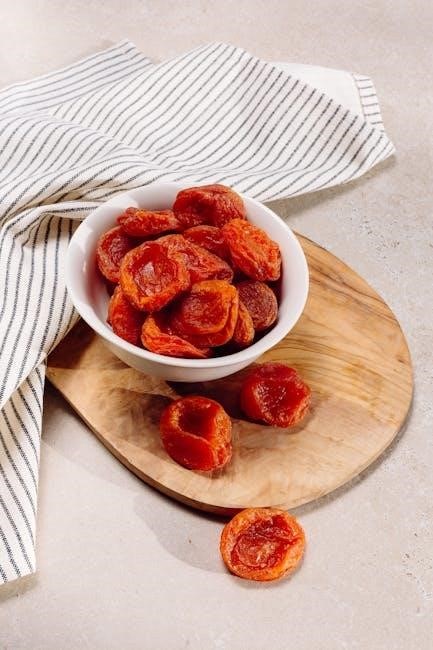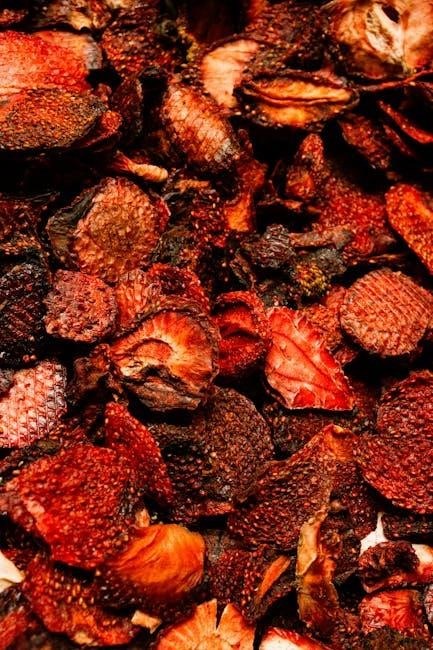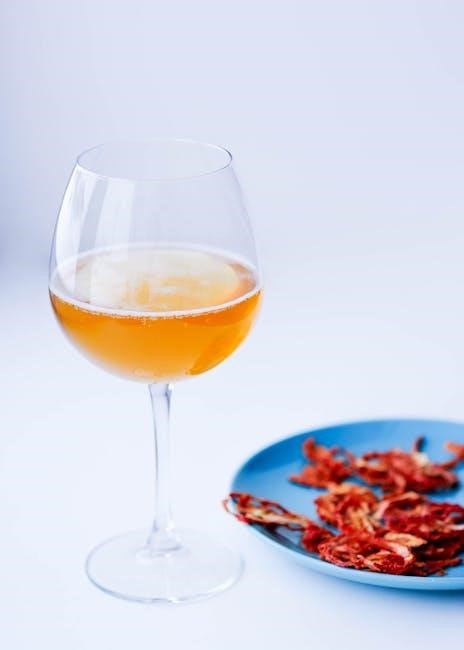A food dehydrator is an essential kitchen tool for preserving food by removing moisture, preventing spoilage, and creating healthy snacks. It promotes sustainable cooking and nutrition.
1.1 What is a Food Dehydrator?
A food dehydrator is a kitchen appliance designed to remove moisture from food, preserving it and preventing bacterial growth. Using low temperatures and a fan for air circulation, it effectively dries fruits, vegetables, meats, and herbs. This device is ideal for creating healthy snacks, jerky, and stored meals, making it a valuable tool for health-conscious individuals and home cooks.
1.2 Benefits of Using a Food Dehydrator
A food dehydrator offers numerous benefits, including reduced food waste, healthy eating options, and lightweight food storage. It preserves nutrients by using low temperatures, making it ideal for health-conscious individuals. Dehydrating also saves money by extending food shelf life and allowing for bulk meal preparation. Additionally, it enables creativity in making snacks, jerky, and specialty items, making it a versatile tool for home cooks and outdoor enthusiasts alike.
Understanding Your Food Dehydrator
Understanding your food dehydrator involves familiarizing yourself with its components and operation. It uses controlled heat and airflow to remove moisture, preserving food effectively and consistently.
2.1 Key Components of a Food Dehydrator
A food dehydrator typically includes a heating element, fan, temperature control, and multiple trays. These components work together to circulate warm air, ensuring even drying. Some models also feature digital displays for precise temperature and time settings, enhancing usability. Understanding these parts helps in operating the device efficiently and achieving optimal dehydration results for various foods.
2.2 How a Food Dehydrator Works
A food dehydrator uses a heating element and fan to circulate warm air, removing moisture from food. This process preserves nutrients and prevents spoilage. The controlled temperature and airflow ensure even drying, while the design maintains food quality. It operates at low temperatures to retain vitamins and enzymes, making it ideal for healthy snacks and meal preparation;

Choosing the Right Food Dehydrator
A food dehydrator is an excellent investment for preserving food and promoting healthy eating. This guide helps you choose the right model based on your needs and preferences.
3.1 Factors to Consider When Selecting a Food Dehydrator
When selecting a food dehydrator, consider size, capacity, and dehydration temperature. Ensure it fits your space and meets your needs. A model with adjustable temperature and timer offers flexibility. Look for features like digital controls, multiple trays, and quiet operation. These elements enhance efficiency and convenience, making food dehydration easier and more enjoyable for home use.
3;2 Popular Food Dehydrator Models and Their Features
Popular models like the Nesco American Harvest and Excalibur offer advanced features. Nesco includes preset temperature guides, while Excalibur features digital controls and large capacity. The Chefman Food Dehydrator offers compact design and affordability. Each model caters to different needs, ensuring there’s an option for every user, from casual to professional food dehydration enthusiasts, making healthy snacks and preserving food efficiently.

Preparing for Dehydration
Preparing for dehydration involves cleaning your workspace, washing and trimming ingredients, and slicing foods uniformly. Pat dry excess moisture to ensure even drying and optimal results.
4.1 Food Preparation Tips for Dehydration
Effective food preparation for dehydration starts with selecting fresh, ripe ingredients. Wash and pat dry fruits and vegetables thoroughly. Slice or chop uniformly to ensure even drying. Remove seeds, pits, and stems to enhance texture and flavor. Blanching vegetables like broccoli or spinach can preserve color and nutrients. For meats, trim fat to prevent spoilage during dehydration. Always follow safety guidelines to avoid contamination.
4.2 Safety Guidelines Before Starting
Before using your food dehydrator, ensure all components are clean and dry. Place the dehydrator on a heat-resistant surface away from flammable materials. Avoid overloading trays to maintain proper airflow. Keep children away during operation. Always follow the manufacturer’s temperature and time recommendations. Unplug the unit when not in use or during cleaning to prevent electrical hazards. Regularly inspect for wear and tear to ensure safe functionality.

Operating Your Food Dehydrator
Set the temperature and timer according to your recipe. Arrange food evenly on trays, ensuring proper air circulation. Start the dehydrator and monitor progress for optimal results.
5.1 Step-by-Step Instructions for Using a Food Dehydrator
Wash and prepare food according to your recipe. Slice or chop evenly for consistent drying. Preheat the dehydrator to the recommended temperature. Place food on trays without overlapping. Set the timer based on your recipe. Allow the dehydrator to run until food reaches desired dryness. Check periodically for even drying. Once done, let cool before storing.
5.2 Setting the Right Temperature and Time
Setting the correct temperature and time is crucial for successful dehydration. Fruits and vegetables typically require temperatures between 135-145°F, while meats for jerky need higher temps, around 160°F. Herbs may need lower temps, 95-115°F. Time varies based on food type and thickness, so check periodically to avoid over-drying. Always consult your dehydrator’s manual or a reliable guide for specific settings.
Dehydrating Specific Foods
Dehydrating specific foods like fruits, vegetables, and jerky requires attention to detail. Each food type has optimal dehydration times and temperatures for best results. Follow guidelines carefully.
6.1 Best Practices for Dehydrating Fruits and Vegetables
For fruits and vegetables, slice evenly and pat dry to ensure uniform dehydration. Set temperatures between 50-70°C for fruits and 50-60°C for vegetables. Avoid overloading trays for proper air circulation. Monitor dehydration time and check dryness by bending or breaking pieces. Store in airtight containers to maintain freshness and prevent spoilage.
6.2 Tips for Making Jerky and Other Specialty Items
For jerky, slice meats thinly and marinate before dehydration. Use a temperature of 70°C to ensure food safety. Avoid overcrowding trays for even drying. Specialty items like fruit leathers require spreading purees evenly on trays. Herbs can be dried at lower temperatures to preserve flavor. Always follow recipe guidelines for optimal results and food safety.
Storing Dehydrated Foods
Store dehydrated foods in airtight containers in a cool, dark place to maintain freshness. Use oxygen absorbers to prevent moisture and extend shelf life effectively.
7.1 Proper Storage Methods for Dehydrated Foods
Store dehydrated foods in airtight containers to protect from moisture and pests. Use glass jars or vacuum-sealed bags and keep them in a cool, dark location. Oxygen absorbers can extend shelf life by removing air. For added protection, bay leaves can deter insects. Always check for any signs of moisture or spoilage before storage. Properly stored foods remain fresh for months, ensuring optimal flavor and nutrition.
7.2 Maintaining Shelf Life and Freshness
To maintain shelf life and freshness, ensure dehydrated foods are completely dry before storage. Store in airtight containers, such as glass jars or vacuum-sealed bags, in a cool, dark place. Use oxygen absorbers to remove air and prevent oxidation. Regularly check for signs of moisture or spoilage. Properly stored foods retain flavor, nutrients, and texture for extended periods. Label containers and store in low-humidity environments for optimal preservation.
Troubleshooting Common Issues
Troubleshooting common issues with your food dehydrator involves identifying problems like uneven drying or overcooked edges. Ensure proper airflow, check temperature settings, and avoid overcrowding trays. For stuck food, lightly spray trays beforehand. Regular cleaning and maintenance can prevent many issues. Always refer to your dehydrator’s manual for specific solutions.
8.1 Common Mistakes to Avoid When Using a Food Dehydrator
Common mistakes include not following temperature guidelines, overcrowding trays, and improper food preparation. Avoid neglecting to clean the dehydrator regularly, as residue can affect performance. Ensure consistent slicing for even drying and monitor food to prevent overdehydration. Always refer to the user manual for specific recommendations tailored to your dehydrator model to achieve optimal results and extend its lifespan.
8.2 Solutions for Undercooked or Overcooked Foods
If food is undercooked, extend dehydration time in short increments until desired dryness is achieved. For overcooked food, remove immediately and store to prevent further drying. Adjust temperature settings for sensitive items and ensure even air circulation by avoiding overcrowded trays. Regularly check food during dehydration to maintain control and achieve consistent results.

Advanced Dehydrator Techniques
Explore advanced methods like custom temperature control, multi-stage drying, and creative food combinations to elevate your dehydration skills and achieve expert-level results effortlessly at home.
9.1 Customizing Dehydration Times and Temperatures
Customizing dehydration times and temperatures allows for precise control over the final texture and flavor of your foods. Understanding the ideal settings for specific ingredients ensures optimal preservation of nutrients and taste. Adjusting the temperature between 50-70°C and monitoring the drying process helps achieve perfect results. Experimenting with time and heat combinations can enhance the quality of dehydrated dishes, making them more versatile and delicious for various recipes.
9.2 Creative Recipes for Your Food Dehydrator
Your food dehydrator offers endless possibilities for creativity. Try making homemade jerky with marinades, fruit leathers from pureed berries, or crispy vegetable chips. Experiment with herbs to create custom spice blends, or dehydrate cooked grains for backpacking meals. The dehydrator also excels at making healthy snacks like kale chips or dried fruit mixes, ensuring delicious and nutritious options for every occasion with minimal effort and maximum flavor.
A food dehydrator is a sustainable way to preserve nutrients, create healthy snacks, and reduce waste. Start dehydrating today for your next delicious meal or backpacking project!
10.1 Final Tips for Mastering Food Dehydration
Mastering food dehydration requires patience and practice. Start with fresh ingredients and monitor progress closely. Store dehydrated foods in airtight containers to maintain freshness. Experiment with new recipes and adjust settings for optimal results. Remember, consistency in slicing and uniform air circulation are key to achieving perfectly dried foods every time. Happy dehydrating!
10.2 Encouragement to Start Dehydrating
Embrace the world of food dehydration for healthier snacks and reduced waste. Start simple with fruits and vegetables, then explore jerky and creative recipes. With practice, you’ll unlock the full potential of your dehydrator, enjoying nutritious, homemade treats year-round. Don’t hesitate—begin your dehydration journey today and discover a new way to preserve and savor your favorite foods!
